Min-Hung Chen
TC-LoRA: Temporally Modulated Conditional LoRA for Adaptive Diffusion Control
Oct 10, 2025
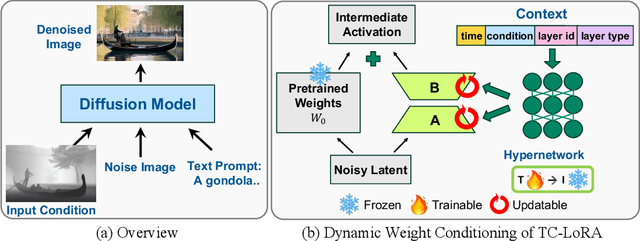

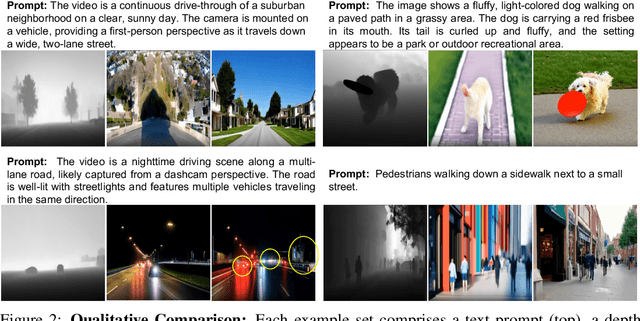
Abstract:Current controllable diffusion models typically rely on fixed architectures that modify intermediate activations to inject guidance conditioned on a new modality. This approach uses a static conditioning strategy for a dynamic, multi-stage denoising process, limiting the model's ability to adapt its response as the generation evolves from coarse structure to fine detail. We introduce TC-LoRA (Temporally Modulated Conditional LoRA), a new paradigm that enables dynamic, context-aware control by conditioning the model's weights directly. Our framework uses a hypernetwork to generate LoRA adapters on-the-fly, tailoring weight modifications for the frozen backbone at each diffusion step based on time and the user's condition. This mechanism enables the model to learn and execute an explicit, adaptive strategy for applying conditional guidance throughout the entire generation process. Through experiments on various data domains, we demonstrate that this dynamic, parametric control significantly enhances generative fidelity and adherence to spatial conditions compared to static, activation-based methods. TC-LoRA establishes an alternative approach in which the model's conditioning strategy is modified through a deeper functional adaptation of its weights, allowing control to align with the dynamic demands of the task and generative stage.
Temporal Prompting Matters: Rethinking Referring Video Object Segmentation
Oct 08, 2025Abstract:Referring Video Object Segmentation (RVOS) aims to segment the object referred to by the query sentence in the video. Most existing methods require end-to-end training with dense mask annotations, which could be computation-consuming and less scalable. In this work, we rethink the RVOS problem and aim to investigate the key to this task. Based on existing foundation segmentation models, we decompose the RVOS task into referring, video, and segmentation factors, and propose a Temporal Prompt Generation and Selection (Tenet) framework to address the referring and video factors while leaving the segmentation problem to foundation models. To efficiently adapt image-based foundation segmentation models to referring video object segmentation, we leverage off-the-shelf object detectors and trackers to produce temporal prompts associated with the referring sentence. While high-quality temporal prompts could be produced, they can not be easily identified from confidence scores. To tackle this issue, we propose Prompt Preference Learning to evaluate the quality of the produced temporal prompts. By taking such prompts to instruct image-based foundation segmentation models, we would be able to produce high-quality masks for the referred object, enabling efficient model adaptation to referring video object segmentation. Experiments on RVOS benchmarks demonstrate the effectiveness of the Tenet framework.
Autoregressive Universal Video Segmentation Model
Aug 26, 2025
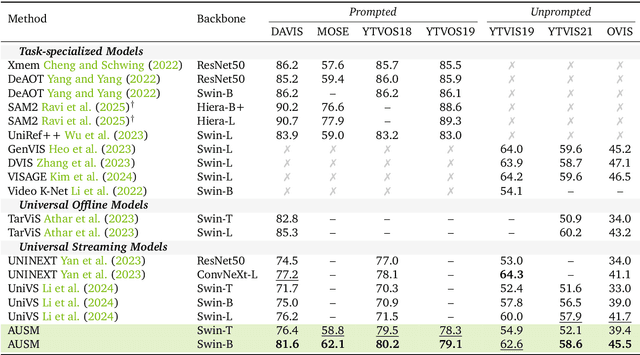
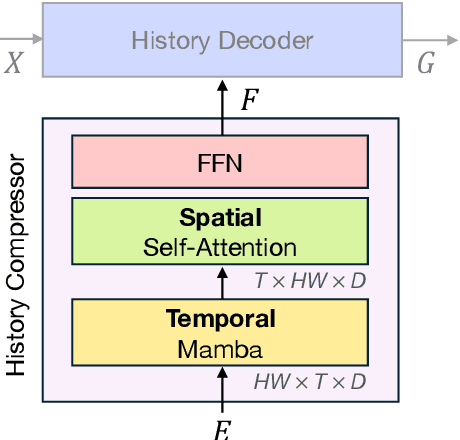

Abstract:Recent video foundation models such as SAM2 excel at prompted video segmentation by treating masks as a general-purpose primitive. However, many real-world settings require unprompted segmentation that aims to detect and track all objects in a video without external cues, leaving today's landscape fragmented across task-specific models and pipelines. We recast streaming video segmentation as sequential mask prediction, analogous to language modeling, and introduce the Autoregressive Universal Segmentation Model (AUSM), a single architecture that unifies both prompted and unprompted video segmentation. Built on recent state-space models, AUSM maintains a fixed-size spatial state and scales to video streams of arbitrary length. Furthermore, all components of AUSM are designed for parallel training across frames, yielding substantial speedups over iterative training. On standard benchmarks (DAVIS17, YouTube-VOS 2018 & 2019, MOSE, YouTube-VIS 2019 & 2021, and OVIS) AUSM outperforms prior universal streaming video segmentation methods and achieves up to 2.5x faster training on 16-frame sequences.
MovieCORE: COgnitive REasoning in Movies
Aug 26, 2025



Abstract:This paper introduces MovieCORE, a novel video question answering (VQA) dataset designed to probe deeper cognitive understanding of movie content. Unlike existing datasets that focus on surface-level comprehension, MovieCORE emphasizes questions that engage System-2 thinking while remaining specific to the video material. We present an innovative agentic brainstorming approach, utilizing multiple large language models (LLMs) as thought agents to generate and refine high-quality question-answer pairs. To evaluate dataset quality, we develop a set of cognitive tests assessing depth, thought-provocation potential, and syntactic complexity. We also propose a comprehensive evaluation scheme for assessing VQA model performance on deeper cognitive tasks. To address the limitations of existing video-language models (VLMs), we introduce an agentic enhancement module, Agentic Choice Enhancement (ACE), which improves model reasoning capabilities post-training by up to 25%. Our work contributes to advancing movie understanding in AI systems and provides valuable insights into the capabilities and limitations of current VQA models when faced with more challenging, nuanced questions about cinematic content. Our project page, dataset and code can be found at https://joslefaure.github.io/assets/html/moviecore.html.
LongSplat: Robust Unposed 3D Gaussian Splatting for Casual Long Videos
Aug 19, 2025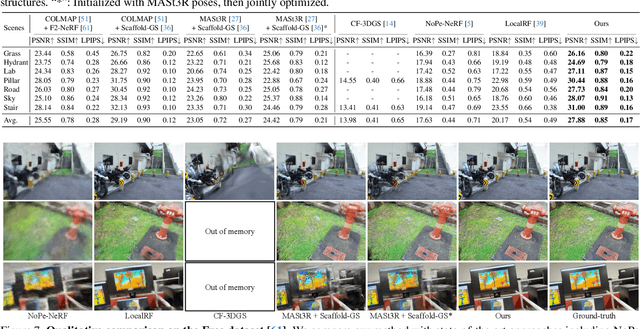
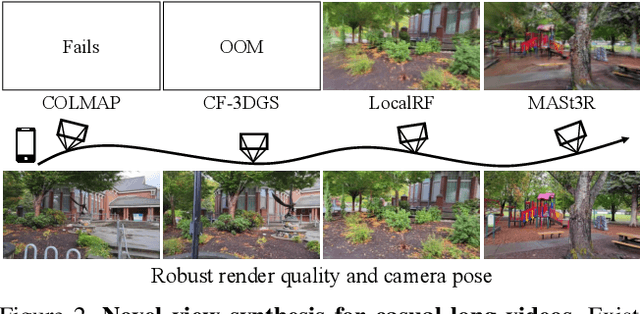
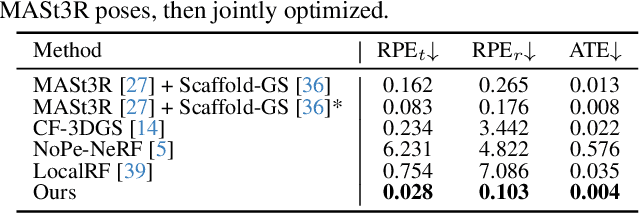
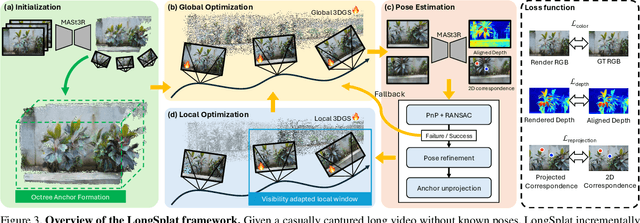
Abstract:LongSplat addresses critical challenges in novel view synthesis (NVS) from casually captured long videos characterized by irregular camera motion, unknown camera poses, and expansive scenes. Current methods often suffer from pose drift, inaccurate geometry initialization, and severe memory limitations. To address these issues, we introduce LongSplat, a robust unposed 3D Gaussian Splatting framework featuring: (1) Incremental Joint Optimization that concurrently optimizes camera poses and 3D Gaussians to avoid local minima and ensure global consistency; (2) a robust Pose Estimation Module leveraging learned 3D priors; and (3) an efficient Octree Anchor Formation mechanism that converts dense point clouds into anchors based on spatial density. Extensive experiments on challenging benchmarks demonstrate that LongSplat achieves state-of-the-art results, substantially improving rendering quality, pose accuracy, and computational efficiency compared to prior approaches. Project page: https://linjohnss.github.io/longsplat/
ThinkAct: Vision-Language-Action Reasoning via Reinforced Visual Latent Planning
Jul 22, 2025



Abstract:Vision-language-action (VLA) reasoning tasks require agents to interpret multimodal instructions, perform long-horizon planning, and act adaptively in dynamic environments. Existing approaches typically train VLA models in an end-to-end fashion, directly mapping inputs to actions without explicit reasoning, which hinders their ability to plan over multiple steps or adapt to complex task variations. In this paper, we propose ThinkAct, a dual-system framework that bridges high-level reasoning with low-level action execution via reinforced visual latent planning. ThinkAct trains a multimodal LLM to generate embodied reasoning plans guided by reinforcing action-aligned visual rewards based on goal completion and trajectory consistency. These reasoning plans are compressed into a visual plan latent that conditions a downstream action model for robust action execution on target environments. Extensive experiments on embodied reasoning and robot manipulation benchmarks demonstrate that ThinkAct enables few-shot adaptation, long-horizon planning, and self-correction behaviors in complex embodied AI tasks.
AuraFusion360: Augmented Unseen Region Alignment for Reference-based 360° Unbounded Scene Inpainting
Feb 07, 2025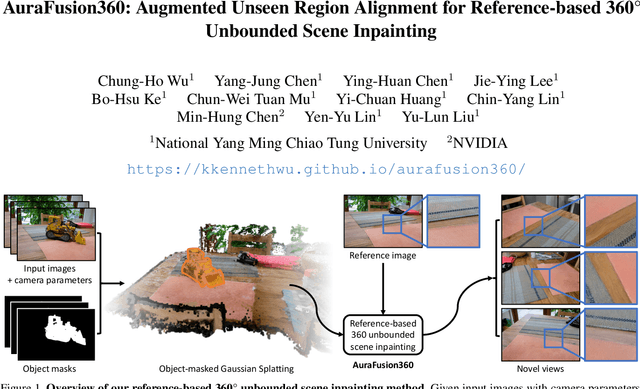

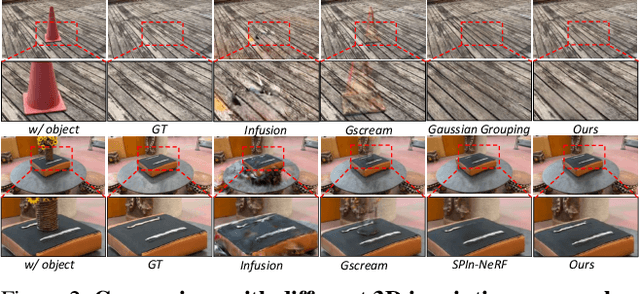
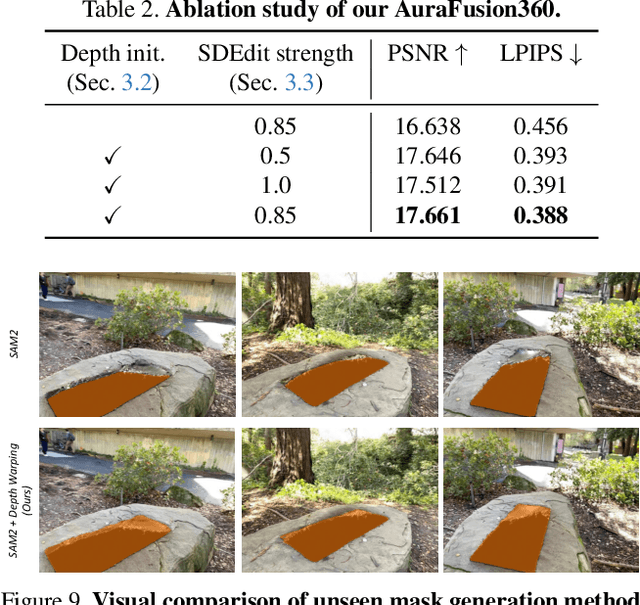
Abstract:Three-dimensional scene inpainting is crucial for applications from virtual reality to architectural visualization, yet existing methods struggle with view consistency and geometric accuracy in 360{\deg} unbounded scenes. We present AuraFusion360, a novel reference-based method that enables high-quality object removal and hole filling in 3D scenes represented by Gaussian Splatting. Our approach introduces (1) depth-aware unseen mask generation for accurate occlusion identification, (2) Adaptive Guided Depth Diffusion, a zero-shot method for accurate initial point placement without requiring additional training, and (3) SDEdit-based detail enhancement for multi-view coherence. We also introduce 360-USID, the first comprehensive dataset for 360{\deg} unbounded scene inpainting with ground truth. Extensive experiments demonstrate that AuraFusion360 significantly outperforms existing methods, achieving superior perceptual quality while maintaining geometric accuracy across dramatic viewpoint changes. See our project page for video results and the dataset at https://kkennethwu.github.io/aurafusion360/.
Omni-RGPT: Unifying Image and Video Region-level Understanding via Token Marks
Jan 14, 2025Abstract:We present Omni-RGPT, a multimodal large language model designed to facilitate region-level comprehension for both images and videos. To achieve consistent region representation across spatio-temporal dimensions, we introduce Token Mark, a set of tokens highlighting the target regions within the visual feature space. These tokens are directly embedded into spatial regions using region prompts (e.g., boxes or masks) and simultaneously incorporated into the text prompt to specify the target, establishing a direct connection between visual and text tokens. To further support robust video understanding without requiring tracklets, we introduce an auxiliary task that guides Token Mark by leveraging the consistency of the tokens, enabling stable region interpretation across the video. Additionally, we introduce a large-scale region-level video instruction dataset (RegVID-300k). Omni-RGPT achieves state-of-the-art results on image and video-based commonsense reasoning benchmarks while showing strong performance in captioning and referring expression comprehension tasks.
CorrFill: Enhancing Faithfulness in Reference-based Inpainting with Correspondence Guidance in Diffusion Models
Jan 04, 2025Abstract:In the task of reference-based image inpainting, an additional reference image is provided to restore a damaged target image to its original state. The advancement of diffusion models, particularly Stable Diffusion, allows for simple formulations in this task. However, existing diffusion-based methods often lack explicit constraints on the correlation between the reference and damaged images, resulting in lower faithfulness to the reference images in the inpainting results. In this work, we propose CorrFill, a training-free module designed to enhance the awareness of geometric correlations between the reference and target images. This enhancement is achieved by guiding the inpainting process with correspondence constraints estimated during inpainting, utilizing attention masking in self-attention layers and an objective function to update the input tensor according to the constraints. Experimental results demonstrate that CorrFill significantly enhances the performance of multiple baseline diffusion-based methods, including state-of-the-art approaches, by emphasizing faithfulness to the reference images.
ORFormer: Occlusion-Robust Transformer for Accurate Facial Landmark Detection
Dec 17, 2024



Abstract:Although facial landmark detection (FLD) has gained significant progress, existing FLD methods still suffer from performance drops on partially non-visible faces, such as faces with occlusions or under extreme lighting conditions or poses. To address this issue, we introduce ORFormer, a novel transformer-based method that can detect non-visible regions and recover their missing features from visible parts. Specifically, ORFormer associates each image patch token with one additional learnable token called the messenger token. The messenger token aggregates features from all but its patch. This way, the consensus between a patch and other patches can be assessed by referring to the similarity between its regular and messenger embeddings, enabling non-visible region identification. Our method then recovers occluded patches with features aggregated by the messenger tokens. Leveraging the recovered features, ORFormer compiles high-quality heatmaps for the downstream FLD task. Extensive experiments show that our method generates heatmaps resilient to partial occlusions. By integrating the resultant heatmaps into existing FLD methods, our method performs favorably against the state of the arts on challenging datasets such as WFLW and COFW.
 Add to Chrome
Add to Chrome Add to Firefox
Add to Firefox Add to Edge
Add to Edge